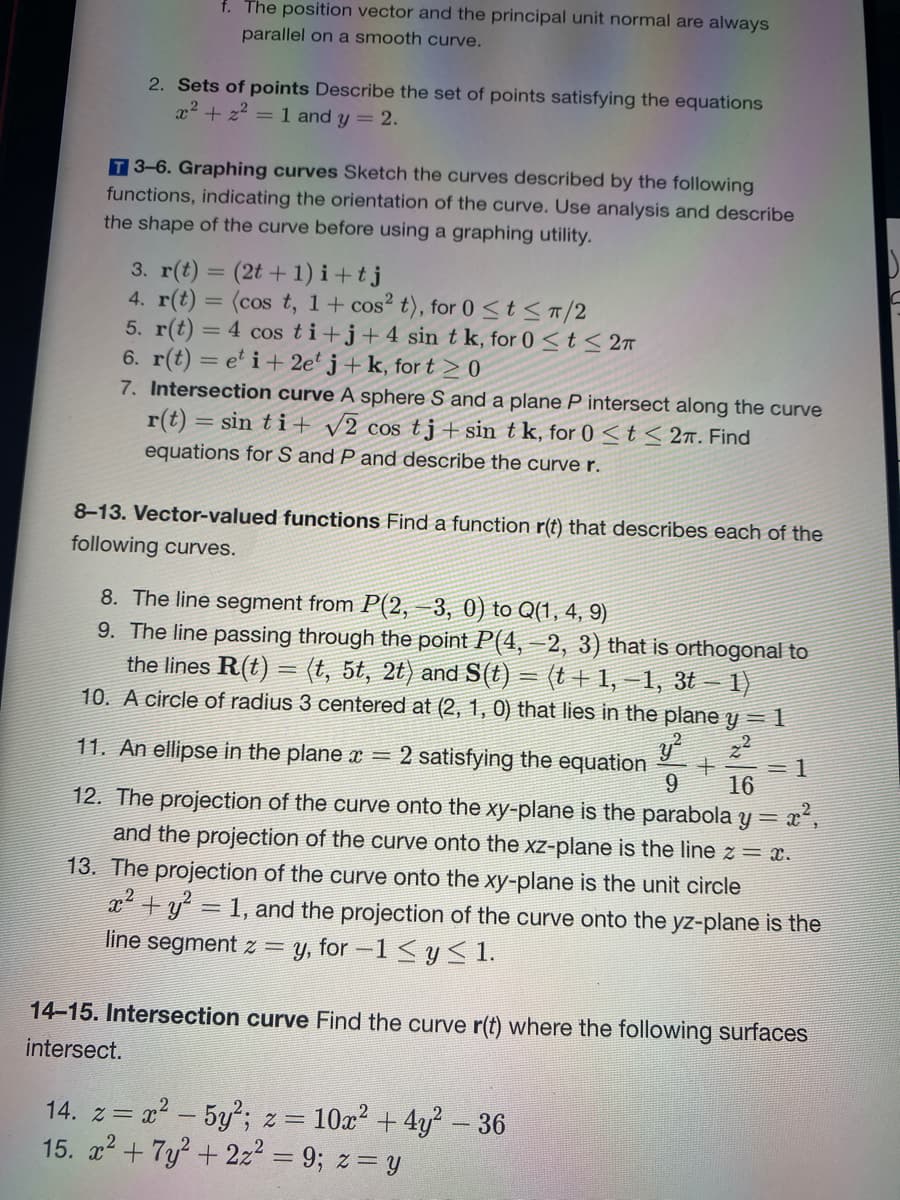8-13. Vector-valued functions Find a function r(t) that describes each of the following curves. 8. The line segment from P(2, -3, 0) to Q(1, 4, 9) 9. The line passing through the point P(4, -2, 3) that is orthogonal to the lines R(t) = (t, 5t, 2t) and S(t) = (t + 1, –1, 3t – 1) 10. A circle of radius 3 centered at (2, 1, 0) that lies in the plane y =1 11. An ellipse in the plane x = 2 satisfying the equation 9 =D1 16 12. The projection of the curve onto the xy-plane is the parabola y = x, and the projection of the curve onto the xz-plane is the line z = x. 13. The projection of the curve onto the xy-plane is the unit circle x + y = 1, and the projection of the curve onto the yz-plane is the |3D line segment z = y, for -1
8-13. Vector-valued functions Find a function r(t) that describes each of the following curves. 8. The line segment from P(2, -3, 0) to Q(1, 4, 9) 9. The line passing through the point P(4, -2, 3) that is orthogonal to the lines R(t) = (t, 5t, 2t) and S(t) = (t + 1, –1, 3t – 1) 10. A circle of radius 3 centered at (2, 1, 0) that lies in the plane y =1 11. An ellipse in the plane x = 2 satisfying the equation 9 =D1 16 12. The projection of the curve onto the xy-plane is the parabola y = x, and the projection of the curve onto the xz-plane is the line z = x. 13. The projection of the curve onto the xy-plane is the unit circle x + y = 1, and the projection of the curve onto the yz-plane is the |3D line segment z = y, for -1
Algebra & Trigonometry with Analytic Geometry
13th Edition
ISBN:9781133382119
Author:Swokowski
Publisher:Swokowski
Chapter11: Topics From Analytic Geometry
Section: Chapter Questions
Problem 18T
Related questions
Question
#11, i know the answer r(t)=
I don’t know the steps to get there

Transcribed Image Text:f. The position vector and the principal unit normal are always
parallel on a smooth curve.
2. Sets of points Describe the set of points satisfying the equations
x2 + z? = 1 and y = 2.
T3-6. Graphing curves Sketch the curves described by the following
functions, indicating the orientation of the curve. Use analysis and describe
the shape of the curve before using a graphing utility.
(2t + 1) i+tj
(cos t, 1+ cos? t), for 0 <t < T/2
3. r(t)
4. г(t)
5. r(t) = 4 cos ti+j+4 sin t k, for 0 < t < 2n
6. r(t) = e' i+ 2e' j+ k, for t > 0
7. Intersection curve A sphere S and a plane P intersect along the curve
r(t) = sin ti+ v2 cos t j +sin t k, for 0<t< 2n. Find
%3D
equations for S and P and describe the curve r.
8-13. Vector-valued functions Find a function r(t) that describes each of the
following curves.
8. The line segment from P(2, -3, 0) to Q(1, 4, 9)
9. The line passing through the point P(4, –2, 3) that is orthogonal to
the lines R(t) = (t, 5t, 2t) and S(t) = (t + 1, – 1, 3t – 1)
10. A circle of radius 3 centered at (2, 1, 0) that lies in the plane y = 1
11. An ellipse in the plane x =
2 satisfying the equation
9.
=D1
16
12. The projection of the curve onto the xy-plane is the parabola y = x,
and the projection of the curve onto the xz-plane is the line z = x.
13. The projection of the curve onto the xy-plane is the unit circle
a? + y
line segment z = y, for -1 <y <1.
1, and the projection of the curve onto the yz-plane is the
14-15. Intersection curve Find the curve r(t) where the following surfaces
intersect.
14. z= x² – 5y; z = 10x² + 4y – 36
15. x2 + 7y? + 2z? = 9; z= y
Expert Solution
This question has been solved!
Explore an expertly crafted, step-by-step solution for a thorough understanding of key concepts.
This is a popular solution!
Trending now
This is a popular solution!
Step by step
Solved in 3 steps

Recommended textbooks for you

Algebra & Trigonometry with Analytic Geometry
Algebra
ISBN:
9781133382119
Author:
Swokowski
Publisher:
Cengage

Algebra & Trigonometry with Analytic Geometry
Algebra
ISBN:
9781133382119
Author:
Swokowski
Publisher:
Cengage